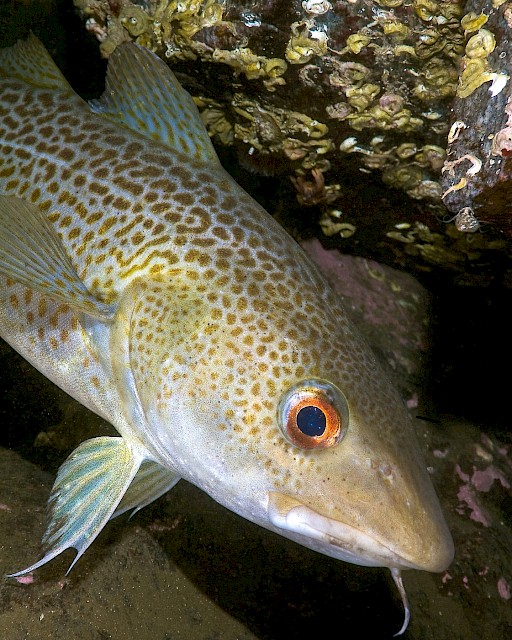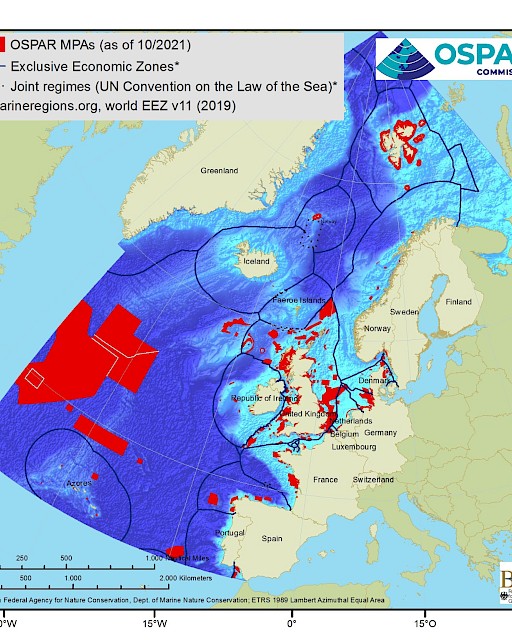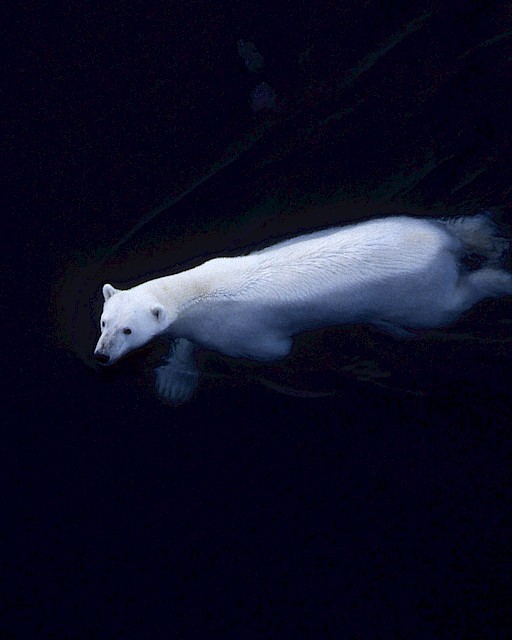Biodiversity Monitoring & Assessment
To achieve the OSPAR vision for a healthy and biodiverse sea, we need to know how our seas function and whether the actions that the OSPAR Contracting Parties agree to take are having the intended effect. Assessing marine biodiversity is a complex task given the large number of possible parameters to consider and the vast areas to be covered.
The OSPAR common indicators assess the changes in populations of marine mammals, seabirds, fish, they look at changes in the phyto- and zoo-plankton communities, benthic habitats and food webs.
Our latest assessments: Quality Status Report 2023
Benthic habitats assessments
Briefing note for the thematic assessment
Condition of Benthic Habitat Communities: Nutrients and/or Organic Enrichment:Coastal water bodies were assessed for only 72% (invertebrates), and 59% (vegetation) of the total area of three OSPAR Regions. From those, the Water Framework Directive quality status was good or high for 79% (invertebrates) and for 86% (vegetation). However, local eutrophic impacted areas were highlighted for 2010 and 2016 reporting cycles.
Condition of Benthic Habitat Communities: Margalef diversity in Region II (Greater North Sea): There was low species diversity in infralittoral sand, - mud and circalittoral sandy habitats in the Greater North Sea. It was moderate/high in offshore areas till 2015, but expected impacts of fisheries might lead to (near) future decreases. Other pressures (e.g., eutrophication, diffuse pollution), are likely to prevent recovery of impacted habitats.
Condition of Benthic Habitat Communities: The Common Conceptual Approach: Assessing the condition of benthic habitat communities against all pressure types is a challenge. Current results are based on the "Margalef species diversity index" and "Assessment of some coastal habitats in relation to nutrient and/or organic enrichment". Only a few habitats and pressure types are included in these assessments, further development is needed.
Extent of Physical Disturbance to Benthic Habitats: Aggregate Extraction: A risk assessment based on available data showed that direct seafloor disturbance caused by aggregate extraction was localised, with less than 0,5% of the area of each habitat disturbed. Sabellaria spinulosa is the only OSPAR Threatened and / or Declining habitat under pressure from extraction but only a small proportion was affected (see also habitat-loss indicator).
Extent of Physical Disturbance to Benthic Habitats: Fisheries with mobile bottom-contacting gears: A risk assessment showed seafloor disturbance caused by fishing occurred in all broad habitat types, 48% of the assessed area in 2016 to 2020, and 53% during 2009 to 2020. ‘High’ disturbance was greatest in Offshore circalittoral mud, alongside Sea-pen and burrowing megafauna communities, whilst disturbance was predominantly ‘Low’ on Offshore circalittoral coarse sediment.
Sentinels of the Seabed: Status of benthic habitats in relation to trawling was assessed in the Bay of Biscay and Iberian Coast region. Offshore circalittoral mud were the most affected habitats (80% highly or moderate disturbed) and upper bathyal sediment the least (46% highly or moderate disturbed). The South Iberian Atlantic assessment is not reliable because of a lack of Portuguese data.
Pilot Assessment of Area of Habitat Loss: Habitat loss is caused by sealing and by other activities leading to substrate changes. 92 km² were lost to offshore structures assessed in the Greater North Sea. A risk assessment highlights areas and habitat types most at risk from bottom trawling. Not all structures and activities contributing to loss are covered.
Fish assessments
Briefing note for thematic assessment
Proportion of Large Fish (Large Fish Index): Long-term declines are evident in the Greater North Sea and Celtic Seas. No change was found in the Bay of Biscay and Iberian coast or Wider Atlantic. The recoveries noted in IA2017 stalled prior to 2020 and thresholds were not met in the North Sea or West of Scotland subdivisions.
Recovery of Sensitive Fish Species: 56 (49%) of 114 regional populations that could support assessment achieved their long-term threshold for "Recovering” and 93 populations (82% of assessed populations) met the secondary threshold “No Further Decline”. 18% (21 populations) did not achieve either threshold, of which 10 populations also showed signs of recent decline. Too few data were available to assess an additional 87 populations.
Size Composition in Fish Communities: The Typical Length indicator measures the size-structure of fish communities and it decreases under high fishing pressure. The indicator is low, compared to the 1980s, in the Greater North Sea and Celtic Seas Regions, but it has increased across large parts of the central Celtic Seas and the northern Bay of Biscay.
Pilot Assessment of Mean Maximum Length of Fish: Change in species composition within fish communities is assessed through change in the mean maximum length indicator. There is no consistent pattern across the assessed Regions, but long-term decreases to minimum values were found for the North Sea. Mixed patterns of increases and decreases were found within all other Regions.
Food web assessments
Briefing note for thematic assessment
Changes in Average Trophic Level of Marine Consumers: The Mean Trophic Level (MTL) showed contrasting trends in the four sub-divisions of the Bay of Biscay and Iberian Coast over recent decades. Although signs of recovery of top predators and mesopredators are observed in most sub-divisions, there were downward trends in some local areas.
Changes in Phytoplankton Biomass and Zooplankton Abundance: Phytoplankton biomass and zooplankton abundance changed significantly (2015-2019), most likely driven by climate change and nutrients. Both components decreased in oceanic habitats (Bay of Biscay), and variable salinity and shelf habitats (Greater North Sea, Celtic Seas). Plankton experienced contrasting trends in all coastal habitats and shelf habitats of the Bay of Biscay and Iberian Coast.
Changes in Plankton Diversity: No significant trends in plankton diversity were detected during 2015-2019 in the Celtic Seas (common indicator assessment), Greater North Sea (pilot assessment), and Bay of Biscay and Iberian Coast (pilot assessment). However, significant but transient changes occurred in one Celtic Seas (2015) and some Greater North Sea (2016, 2019) assessment units.
Changes in Phytoplankton and Zooplankton Communities: Between 2015 and 2019 plankton functional groups experienced significant changes in abundance, reflecting a continuation of long-term trends. Larvae of benthic invertebrates increased, while other groups mostly decreased. Observed changes were primarily linked to rising temperatures within offshore areas in the North-East Atlantic, and to nutrients in some coastal areas.
Pilot Assessment of Ecological Network Analysis Indices: The Ecological Network Analysis indices support the assessment of the structure and functioning of food webs by analysing interactions between all ecosystem components for four case studies. Different trends of indices were found over time and space, some linked to variability in primary production.
Pilot Assessment of Feeding Guilds: Spatially extensive decreases in planktivore feeding guild biomass lower in the food web were evident in the North Sea and Bay of Biscay sub-divisions. In contrast, biomass of the pisco-crustivore and piscivore feeding guilds higher in the food web increased in the Celtic Seas region and Bay of Biscay sub-division.
Pilot Assessment of Primary Productivity: Primary production sustains the functioning of marine food webs. Over the long-term (1997-2019) primary production was stable in the Greater North Sea, Celtic Seas and Bay of Biscay and Iberian Coast. Significant decreases occurred between 2015 and 2019, likely driven by reduced nutrient availability and climate change, which may disturb higher trophic levels.
Marine mammal assessments
Briefing note for thematic assessment
Abundance and Distribution of Cetaceans: Harbour porpoise distribution shifted southward within the Greater North Sea. Abundance appears stable except for a decline in the Irish and Celtic Seas. Assessed populations of coastal bottlenose dolphin appear stable except for a decline in the Sado Estuary. Overall, more frequent large-scale surveys are needed for future quantitative assessment.
Grey Seal Pup Production: In Assessment Units across the Greater North Sea and Celtic Seas, grey seal pup production is largely increasing or stable. Within Arctic Waters, where Iceland was the single assessment unit able to be assessed, grey seal pup production has declined since the baseline assessment year.
Marine Mammal By-catch: This assessment concluded by-catch is a significant pressure affecting marine mammal (Harbour Porpoise; Common Dolphin; Grey Seal) populations in the North-East Atlantic (Greater North Sea (Region II), Celtic Seas (Region III), Bay of Biscay and Iberian Coast (Region IV)), with harbour porpoise and common dolphin exceeding the thresholds. Grey seal did not exceed the thresholds.
The assessment is underpinned by a conservation objective attempting to capture European ambition for by-catch levels, subject to adjustment for future assessments to accommodate new evidence.
Seal Abundance and Distribution: Grey seal abundance is largely increasing across the assessed area. Within Arctic Waters, both Icelandic grey seals and harbour seals are declining. Harbour seals abundance trends are mixed within the Greater North Sea. Southern Celtic Seas data were limited, but trends are generally increasing. Distribution appears generally stable for both species.
Pilot Assessment of Marine Mammal By-catch in Arctic Waters: Marine mammal by-catch is a significant pressure affecting populations in the North-East Atlantic. In Arctic Waters (Region I), a Pilot Assessment was possible for two species (harbour porpoise and grey seal) in the Iceland Assessment Unit (AU) based on the US conservation objective (PBR), resulting in grey seal exceeding and harbour porpoise not exceeding the threshold value.
Pilot Assessment of Status and Trends of Persistent Chemicals in Marine Mammals: Polychlorinated biphenyls (PCBs) are present in marine mammals living in all five OSPAR Regions. Toothed-cetaceans and some subpopulations of pinnipeds present moderate to high ranges of PCB concentrations, often surpassing the estimated toxicity thresholds for the onset of reproductive incapacity. The ranges of PCB concentrations of baleen whales are always below the estimated toxicity thresholds.
Marine bird assessments
Briefing note for the thematic assessment
Marine Bird Abundance: Marine birds are in poor status and declining in most of the OSPAR Maritime Area. This mainly refers to birds feeding at the water surface, diving to the seafloor or foraging in shallow water / on mudflats, whereas birds feeding in the water column and herbivores are usually doing better.
Marine Bird Breeding Productivity: Across Arctic Waters, Greater North Sea and Celtic Seas (OSPAR Regions I, II and III), for most species marine bird breeding productivity was so poor that future population size declines are likely. Breeding productivity was above threshold for the two species assessed in Bay of Biscay and Iberian coast (Region IV).
Pilot Assessment of Marine Bird Abundance - Non-Breeding Offshore Birds: The indicator shows the abundance of seven marine bird species wintering at sea in the North Sea sections of Belgium, the Netherlands and Germany in the assessment period 2015 to 2020 compared against the baseline years (1991 to 2000). The status differed between the seven species assessed and is not related to the functional species group these species belong to.
Pilot Assessment of Marine Bird Bycatch: By-catch of marine birds in fishing gear is an ongoing problem in the North-East Atlantic concerning a number of species. Though methods are developed, a considerable data paucity impairs a comprehensive assessment. In the few cases where an assessment was possible, the threshold value was either achieved or not achieved.
Pilot Assessment of Marine Bird Habitat Quality: The human maritime activities shipping and offshore wind farming negatively affect marine birds wintering at sea in the south of the Greater North Sea (OSPAR Region II), whereas no negative effect of bottom-trawling fishery was found in the species examined. This pilot assessment helps to identify causes for decline in marine birds and to direct conservation measures appropriately.
Non-indigenous species assessment
Briefing note for thematic assessment
Trends in New Records of Non-indigenous Species Introduced by Human Activities: Non-indigenous species (NIS) continue to arrive in high numbers to OSPAR Regions, with potential negative effects on ecosystems. The rate of introduction, mostly crustaceans and macroalgae, is slightly decreasing in Greater North Sea (Region II), Celtic Seas (Region III), and Bay of Biscay and Iberian Coast (Region IV), although lag time in report might explain this trend. Current monitoring shortfalls disable assessment of NIS dispersal and impact.
Pelagic habitats assessments
Briefing note for the thematic assessment
Changes in Phytoplankton and Zooplankton Communities: Between 2015 and 2019 plankton functional groups experienced significant changes in abundance, reflecting a continuation of long-term trends. Larvae of benthic invertebrates increased, while other groups mostly decreased. Observed changes were primarily linked to rising temperatures within offshore areas in the North-East Atlantic, and to nutrients in some coastal areas.
Changes in Plankton Diversity: No significant trends in plankton diversity were detected during 2015-2019 in the Celtic Seas (common indicator assessment), Greater North Sea (pilot assessment), and Bay of Biscay and Iberian Coast (pilot assessment). However, significant but transient changes occurred in one Celtic Seas (2015) and some Greater North Sea (2016, 2019) assessment units.
Changes in Phytoplankton Biomass and Zooplankton Abundance: Phytoplankton biomass and zooplankton abundance changed significantly (2015-2019), most likely driven by climate change and nutrients. Both components decreased in oceanic habitats (Bay of Biscay), and variable salinity and shelf habitats (Greater North Sea, Celtic Seas). Plankton experienced contrasting trends in all coastal habitats and shelf habitats of the Bay of Biscay and Iberian Coast.
Pilot Assessment of Primary Productivity: Primary production sustains the functioning of marine food webs. Over the long-term (1997-2019) primary production was stable in the Greater North Sea, Celtic Seas and Bay of Biscay and Iberian Coast. Significant decreases occurred between 2015 and 2019, likely driven by reduced nutrient availability and climate change, which may disturb higher trophic levels.
More information on OSPAR Indicators
Common indicators assess change over time for the included parameters against a threshold value or assessment value. The indicators have been developed to provide regionally comparable assessment outputs across the OSPAR maritime area and to be responsive to pressures from human activities. Meeting all these requirements is a significant technical challenge and these aspects are still being further developed.
Common indicators build on parameters which are measured in environmental monitoring programmes, whenever possible, to ensure long-term availability of data to support assessments. The OSPAR Coordinated Environmental Monitoring Programme (CEMP) describes monitoring activities in the region. The appendices to the CEMP Agreement provide an overview of the parameters included in the monitoring programmes of each Contracting Party. Further details on the monitoring approaches and the assessment methods applied to the monitoring data in calculating the common indicator assessments are provided in the CEMP Guidelines. The biodiversity CEMP appendices and CEMP guidelines have not yet reached a stage of completion and are being continuously improved.
The process of identifying regional biodiversity indicators was described in an advice manual published in 2012. Developing and maintaining a suite of operational common indicators is a relatively young area of work for OSPAR. The procedures continue to be adapted and improved, the documentation of the indicators is strengthened and data arrangements continue to be developed towards operationalisation.
EcApRHA Project
The EcApRHA project (Applying an Ecosystem Approach to (sub) Regional Habitat Assessment) co-financed by the EU DG Environment was a 15-month (December 2015 – February 2017) project, which focused on addressing gaps in the development of biodiversity (pelagic, benthic and food webs) indicators for the OSPAR Regions. In particular, the project aimed to overcome challenges in the development of indicators relating to the MSFD (Marine Strategy Framework Directive 56/2008/EU), such as Descriptor D1 (Biodiversity), D4 (Food webs) and D6 (Seafloor integrity).
All project deliverables and further information can be found here https://www.ospar.org/work-areas/bdc/ecaprha



